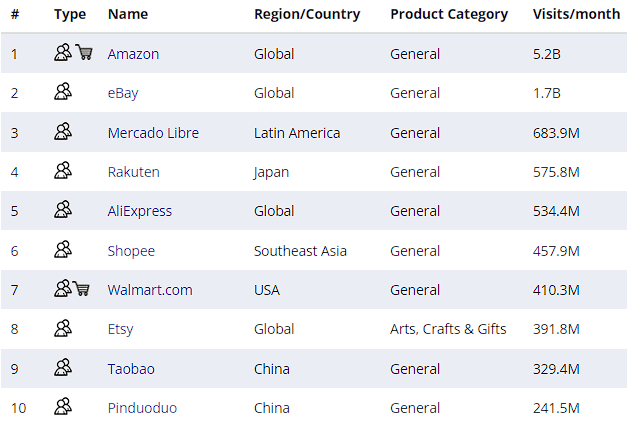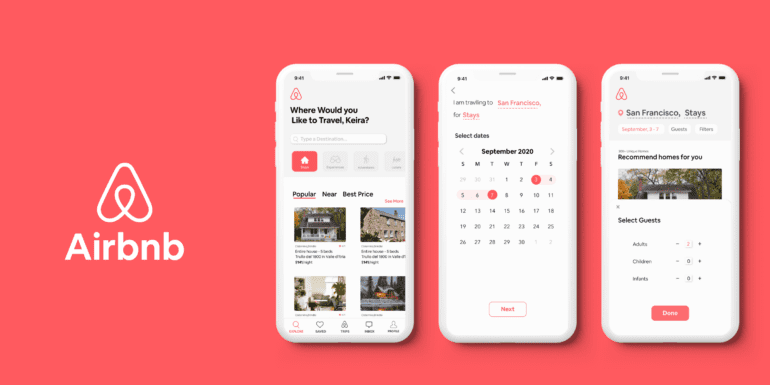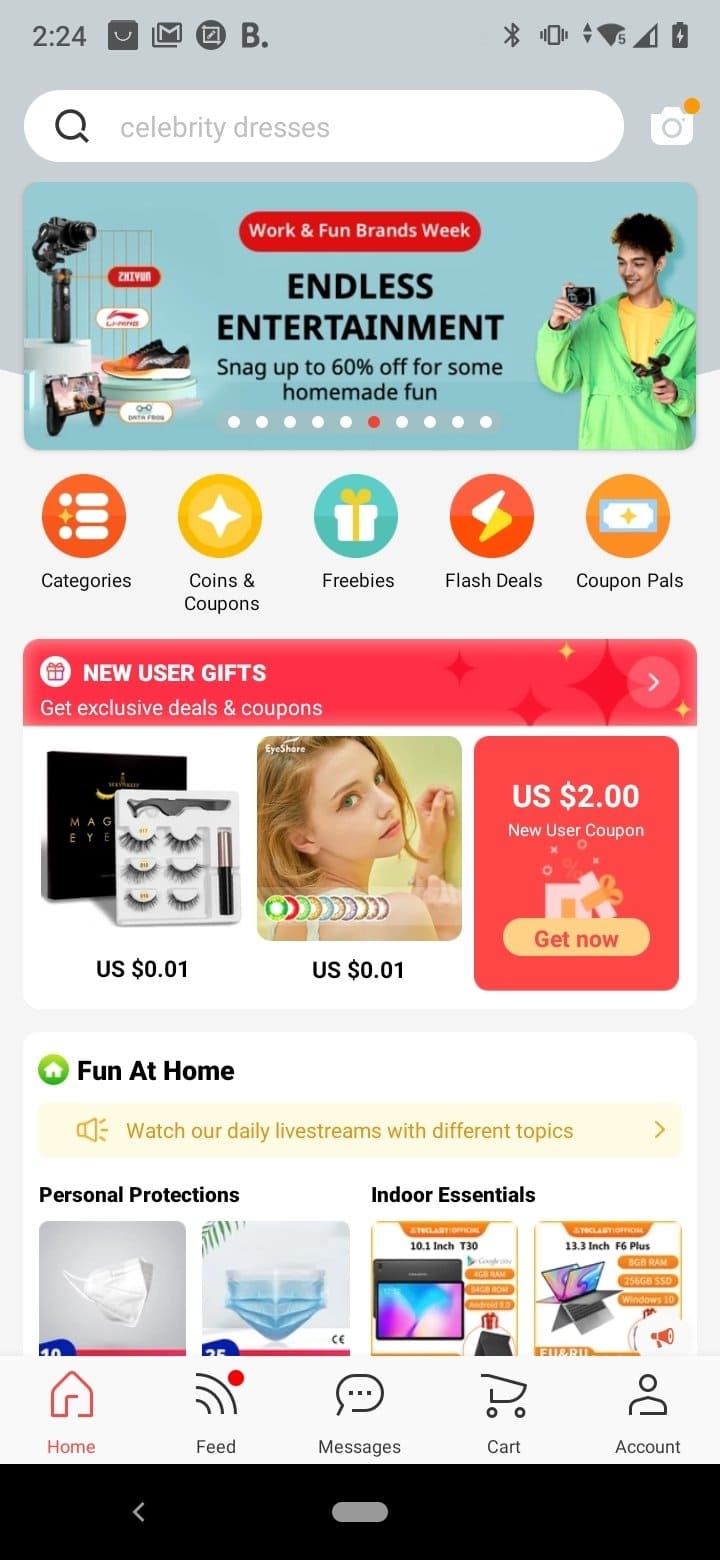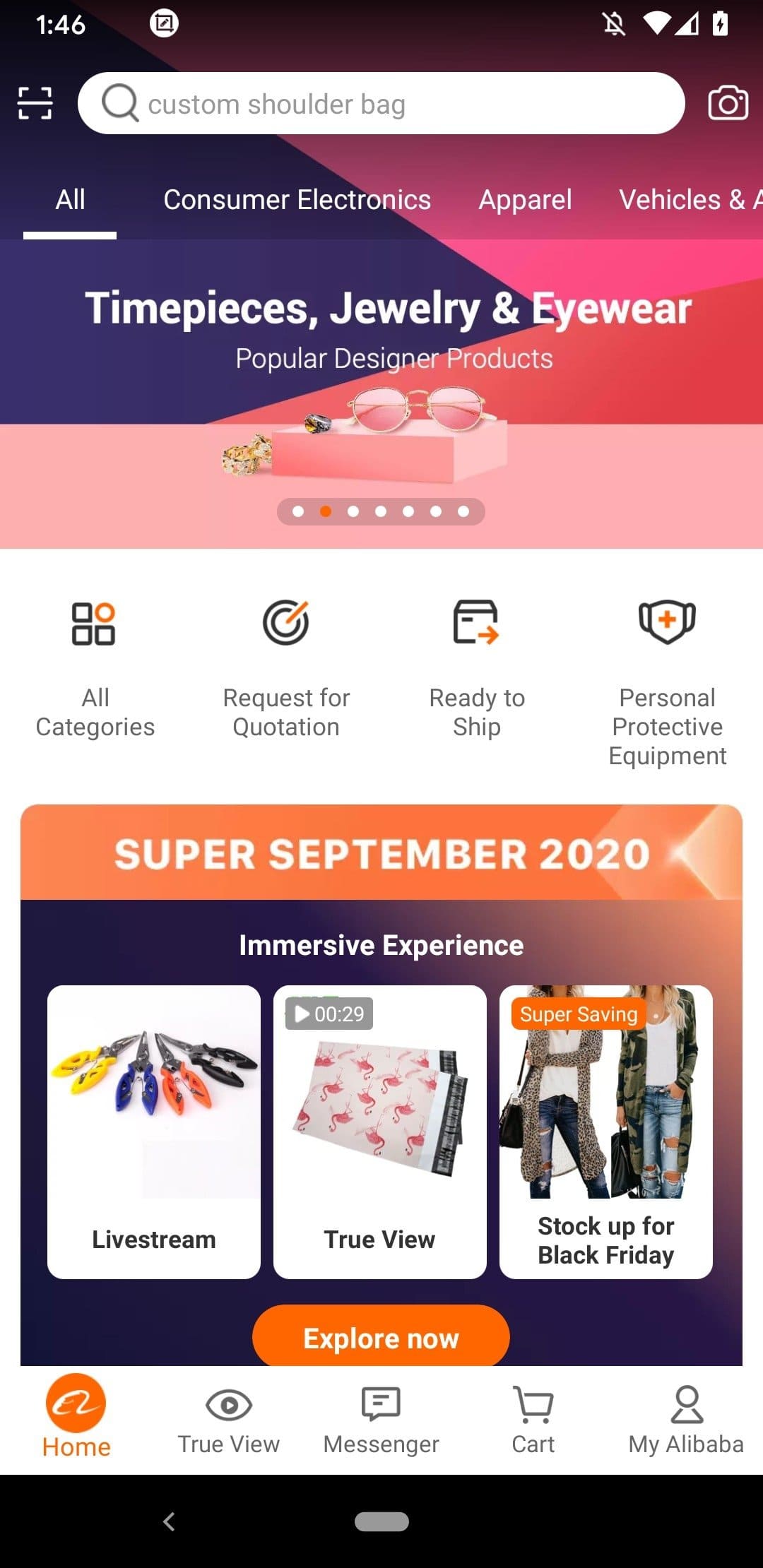Marketplace is one of the most profitable types of online businesses. Creating a marketplace now means starting a profitable project and attracting a lot of users. We have prepared a guide for those who want to know how to build a marketplace like Amazon or eBay. We answer all questions related to the development of an online store and talk about the needed features and technology stack. Enjoy reading!
In 2016, 209.6 million U.S. people were online shoppers and browsed products, compared prices or bought merchandise online at least once. These figures are projected to reach 230.5 million in 2022. In 2021, $3.23 trillion worth of goods were sold in the world’s leading online marketplaces. Sales through platforms such as Alibaba, Amazon, eBay, and others accounted for two-thirds of global e-commerce sales last year, according to Digital Commerce 360 analysis.
There are some more interesting statistics related to marketplaces:

As you can see, top online marketplaces gather a huge audience and receive huge incomes. It may seem strange that in the almost 30 years since Jeff Bezos launched Amazon in 1994, the popularity of marketplaces is still growing. The reason is simple: people love buying and selling on the Internet.
Come to think of it, a marketplace creates win-win conditions for all parties engaged. Being a marketplace owner, you connect customers with a certain pain point with the service providers that can solve that very problem. There is no need to own huge warehouses or hire hundreds of employees.
So, let’s move on to the most important question: how to build a marketplace? In the following blocks, we will try to answer all the questions related to creating your own online store.
For the user part of applications, frontend, we use our proven stack: React, Angular, JavaScript, SAAS, HTML5. Backend, the server side, is developed using the following technologies: C# and Node.js. As for mobile app development, Objective-C and Swift are used for iOS, and Kotlin and Java for Android OS. Using React Native, we can create a mobile app for both operating systems.
The advantage of these technologies is that we can make the application scalable and able to cope with high loads. For example, if traffic to your marketplace rapidly increases, the site will not fall, but will continue to work properly. Also, with such a stack, adding new features or sections will not be a problem. This is the reason why we do not recommend using website builders or no-code solutions to create a marketplace. Let us explain.
Website builders have two main problems: scaling and optimization. Firstly, as we already mentioned, when it comes to new functionality, it will be almost impossible to expand a site made with a builder. The reason is that they offer a limited amount of options for users.
Secondly, it can take weeks to optimize the site for sellers and buyers. This includes understanding the user journey and customizing each plugin and extension to meet the high expectations of users for a good experience.
So choosing a ‘convenient’ solution today, you get a new problem tomorrow. Therefore, it makes sense to take care of the quality of the site at the start and hire an experienced development team to build a marketplace.
If you do not have a large budget, we advise you to make an MVP. A minimal viable product, made on a good stack, will allow you to develop it into a full-fledged project in the future. At the same time, even a well-made, but made-in-builder marketplace will later bring losses because it will take a lot of money to transfer it to working technologies.
✔️ Login
Clothes make the man, but the login page makes the marketplace. Make the registration process as simple as possible for the user. It is unlikely that buyers want to break away from shopping for a long time in order to go through a complicated registration on the site. Add the ability to register automatically via email or social networks.
✔️ Buyer’s personal account
Buyers should feel comfortable on your site. Create a smart shopping space for them: there should be wishlists, a Favorites tab, and a shopping cart in their personal account. A user-friendly UI/UX design determines how long customers stay in the marketplace and whether they end up making a purchase.
✔️ Seller’s personal account
Remember about the comfort of sellers, too. Their personal account should have tools for creating a product card, tracking purchases, and an easy way to withdraw money from the account.
✔️ Ratings and reviews
It has been proven that product reviews increase customer loyalty to the marketplace platform. You can also add photo and video reviews. Another useful feature is seller rating, so buyers will always know who to trust.
✔️ Payment options
Add as many payment options as possible: in cash or by card to the courier or at the pickup point, online on the website by card or PayPal. You can also add credit or installment payments. In this case, you need to establish cooperation with the bank.
✔️ Safety
Safety first. Do everything to keep user data secure. Even one leak will ruin the reputation of your marketplace platform forever. SSL certificates and PCI compliance are the mandatory features that help to ensure the safety of your customers.
✔️ Some other features
And a few more important features for the marketplace. Push notifications — this is how sellers always stay in touch with users, and also remind them of promotions or special offers. The ability to share a product on social networks — people like sending each other interesting things. And you get free advertising from a loyal audience. Technical support 24/7 — specialists should always be in touch to help the users with any problem. Create a special chat in the application and don’t force customers to call technical support.
You may also have heard that there is a certain client-to-client segment of marketplaces. So: C2C is the same as P2P. The only difference is that in the C2C form, the seller and the buyer can change roles, while in P2P these roles are strictly defined: if someone buys goods, they can’t sell them from a personal account.
Peer-to-peer platforms include rental (Airbnb), product (eBay, Etsy), service (Helpware, TaskRabbit), and money/loan (Kickstarter, GoFundMe) marketplaces.

In the previous example, Airbnb customers stay in apartments rented directly by their owners. As an instance of B2C format, people book hotel rooms through a service like Booking.com. Another successful example is AliExpress. They offer goods from companies-producers: from clothes and household appliances to cars and bikes.

A good example of this segment is the Alibaba marketplace, which allows entrepreneurs to buy goods wholesale. The site presents more than 40 categories of various goods, from clothing to agricultural machinery. Any product can be ordered in bulk in large quantities.

Why is it worth creating a marketplace?
Marketplaces are popular online shopping platforms, as consumers are attracted to the large number of products available typically at lower prices.In 2016, 209.6 million U.S. people were online shoppers and browsed products, compared prices or bought merchandise online at least once. These figures are projected to reach 230.5 million in 2022. In 2021, $3.23 trillion worth of goods were sold in the world’s leading online marketplaces. Sales through platforms such as Alibaba, Amazon, eBay, and others accounted for two-thirds of global e-commerce sales last year, according to Digital Commerce 360 analysis.
There are some more interesting statistics related to marketplaces:
- 40 of the 100 top marketplaces launched in the last decade. These include retailers that have been around for a while and have just recently begun allowing other sellers to sell on their sites.
- $919 billion were spent in marketplaces in America last year.
- 63% of users buy staff from mobile apps.
- Top marketplaces are located in North America (51), Europe (22), Asia (7), Latin America (7), and Middle East/Africa (3).
- 55% is the growth of ‘Chairish’, a vintage home furniture market in the US. This is the fastest marketplace growth in history.

Top 10 leaders of the market.
As you can see, top online marketplaces gather a huge audience and receive huge incomes. It may seem strange that in the almost 30 years since Jeff Bezos launched Amazon in 1994, the popularity of marketplaces is still growing. The reason is simple: people love buying and selling on the Internet.
Come to think of it, a marketplace creates win-win conditions for all parties engaged. Being a marketplace owner, you connect customers with a certain pain point with the service providers that can solve that very problem. There is no need to own huge warehouses or hire hundreds of employees.
So, let’s move on to the most important question: how to build a marketplace? In the following blocks, we will try to answer all the questions related to creating your own online store.
What technical stack is used to build a marketplace?
To create a marketplace, development companies use a certain stack of technologies. Experts use different programs for desktop and mobile app development. Let’s see how the development of the marketplace looks from the technical side.For the user part of applications, frontend, we use our proven stack: React, Angular, JavaScript, SAAS, HTML5. Backend, the server side, is developed using the following technologies: C# and Node.js. As for mobile app development, Objective-C and Swift are used for iOS, and Kotlin and Java for Android OS. Using React Native, we can create a mobile app for both operating systems.
The advantage of these technologies is that we can make the application scalable and able to cope with high loads. For example, if traffic to your marketplace rapidly increases, the site will not fall, but will continue to work properly. Also, with such a stack, adding new features or sections will not be a problem. This is the reason why we do not recommend using website builders or no-code solutions to create a marketplace. Let us explain.
Why is a website builder not the best idea for a marketplace?
Website builders do seem like an affordable option for those who aren’t ready to hire an entire development team. This solution is cheaper and faster than building a marketplace from scratch. But if you want to create a marketplace equal in capabilities to top competitors, a website builder is not enough.Website builders have two main problems: scaling and optimization. Firstly, as we already mentioned, when it comes to new functionality, it will be almost impossible to expand a site made with a builder. The reason is that they offer a limited amount of options for users.
Secondly, it can take weeks to optimize the site for sellers and buyers. This includes understanding the user journey and customizing each plugin and extension to meet the high expectations of users for a good experience.
So choosing a ‘convenient’ solution today, you get a new problem tomorrow. Therefore, it makes sense to take care of the quality of the site at the start and hire an experienced development team to build a marketplace.
If you do not have a large budget, we advise you to make an MVP. A minimal viable product, made on a good stack, will allow you to develop it into a full-fledged project in the future. At the same time, even a well-made, but made-in-builder marketplace will later bring losses because it will take a lot of money to transfer it to working technologies.
What features are crucial for a marketplace?
Without these features, an online marketplace will not be real. Pay attention to these features: some of them are important in the development of any type of application or site, while others are specific to marketplaces. In any case, customers expect to see a marketplace with familiar functionality and high-quality user experience.✔️ Login
Clothes make the man, but the login page makes the marketplace. Make the registration process as simple as possible for the user. It is unlikely that buyers want to break away from shopping for a long time in order to go through a complicated registration on the site. Add the ability to register automatically via email or social networks.
✔️ Buyer’s personal account
Buyers should feel comfortable on your site. Create a smart shopping space for them: there should be wishlists, a Favorites tab, and a shopping cart in their personal account. A user-friendly UI/UX design determines how long customers stay in the marketplace and whether they end up making a purchase.
✔️ Seller’s personal account
Remember about the comfort of sellers, too. Their personal account should have tools for creating a product card, tracking purchases, and an easy way to withdraw money from the account.
✔️ Ratings and reviews
It has been proven that product reviews increase customer loyalty to the marketplace platform. You can also add photo and video reviews. Another useful feature is seller rating, so buyers will always know who to trust.
✔️ Payment options
Add as many payment options as possible: in cash or by card to the courier or at the pickup point, online on the website by card or PayPal. You can also add credit or installment payments. In this case, you need to establish cooperation with the bank.
✔️ Safety
Safety first. Do everything to keep user data secure. Even one leak will ruin the reputation of your marketplace platform forever. SSL certificates and PCI compliance are the mandatory features that help to ensure the safety of your customers.
✔️ Some other features
And a few more important features for the marketplace. Push notifications — this is how sellers always stay in touch with users, and also remind them of promotions or special offers. The ability to share a product on social networks — people like sending each other interesting things. And you get free advertising from a loyal audience. Technical support 24/7 — specialists should always be in touch to help the users with any problem. Create a special chat in the application and don’t force customers to call technical support.
What types of marketplaces exist?
Don’t be surprised: there are different types of marketplace platforms. They differ in target audience, focus, content (products, services or all at once). On this block, we are going to introduce you to several types of online marketplaces.🔴 Peer-to-peer marketplace
P2P marketplace is a platform that matches people who need goods or services with people selling or renting these goods or services. In the P2P marketplace, salespeople can sell any products. To do this, they do not need to be businessmen and have their own brand. This makes it relatively inexpensive to start a business in the market.You may also have heard that there is a certain client-to-client segment of marketplaces. So: C2C is the same as P2P. The only difference is that in the C2C form, the seller and the buyer can change roles, while in P2P these roles are strictly defined: if someone buys goods, they can’t sell them from a personal account.
Peer-to-peer platforms include rental (Airbnb), product (eBay, Etsy), service (Helpware, TaskRabbit), and money/loan (Kickstarter, GoFundMe) marketplaces.

Airbnb is an example of the peer-to-peer marketplace.
🔴 Business-to-customer marketplace
The difference between a B2C platform and a P2P platform is that business is involved. The main interaction is between an entrepreneur and a client. Businessmen have their own brand and certain goods that they sell on the B2C platform.In the previous example, Airbnb customers stay in apartments rented directly by their owners. As an instance of B2C format, people book hotel rooms through a service like Booking.com. Another successful example is AliExpress. They offer goods from companies-producers: from clothes and household appliances to cars and bikes.

AliExpress is an example of the B2C marketplace.
🔴 Business-to-business marketplace
By the name of this type, you can guess that we will talk about the interaction of businesses through marketplaces. In the B2B marketplace segment, some entrepreneurs sell goods and services to others on favorable terms. Also, businesses can use such sites to search for partners.A good example of this segment is the Alibaba marketplace, which allows entrepreneurs to buy goods wholesale. The site presents more than 40 categories of various goods, from clothing to agricultural machinery. Any product can be ordered in bulk in large quantities.

Alibaba is an example of the B2B marketplace.
Short recommendation for launching a marketplace
Take another look at the statistics: marketplaces have been growing for a decade and will continue to grow in the future. Choose a niche that suits you and start a business right now. Your unique idea can be a great addition to the diverse global online shopping market.At Brivian, we have expertise in developing scalable and quality marketplaces in terms of user experience. We provide both desktop and mobile app development services. Feel free to contact us, and we’ll discuss your ideas!
Related Articles